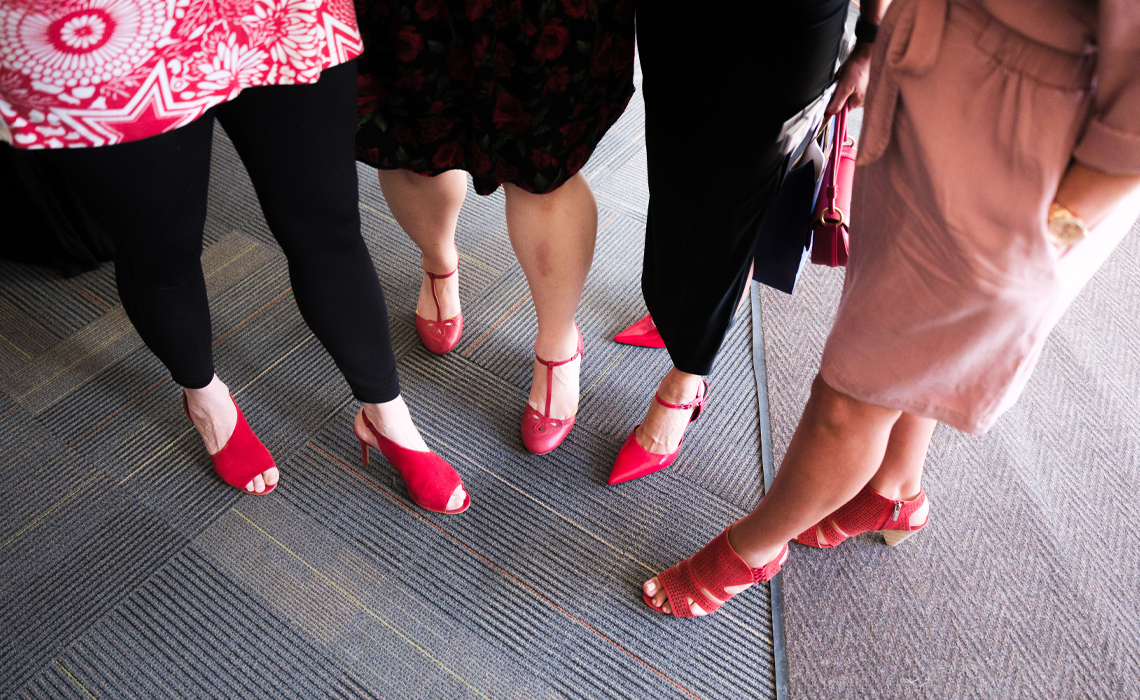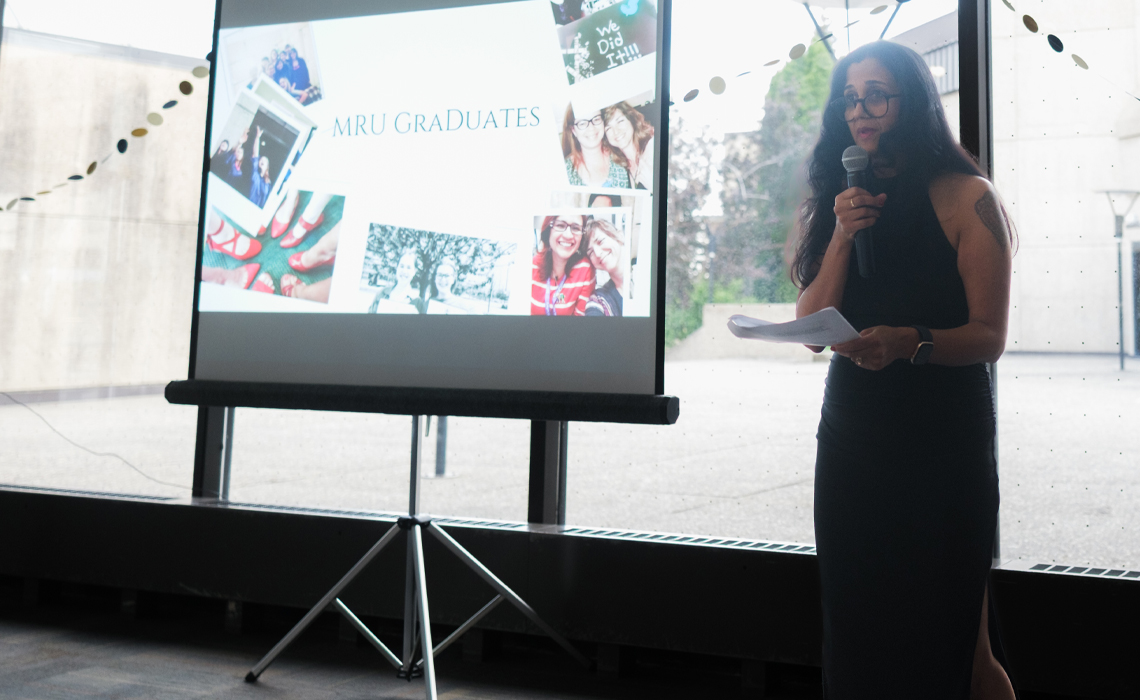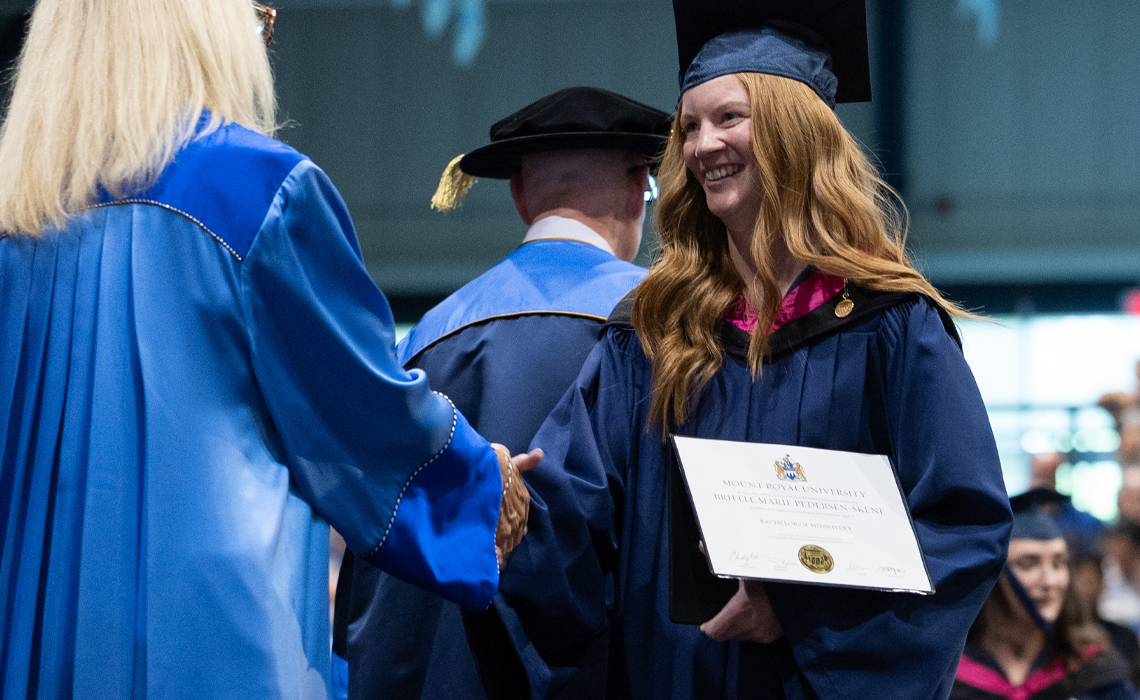A decade of dedication and impact

Alberta’s only midwifery degree program is celebrating ten years of graduates.
Mount Royal’s Bachelor of Midwifery program was launched in the fall of 2011. Four years later, in 2015, a class of just eight graduates walked the stage to collect their parchments.
In the ten years since then, just over one hundred midwifery students have followed in their footsteps, notably, all in a similar fashion. Interestingly, during the convocation ceremony for the Faculty of Health, Community and Education there is a distinct, common theme among the midwifery grads: they all wear red shoes.

While the shades may vary, there is an unmistakably uniform look. Whether they are sneakers, heels, sandals or rollerblades (yes, that has happened), graduates proudly strut the stage in their scarlet shoes. The exact origins of the tradition are open to debate, but according to McMaster University the tradition stems from Ontario where graduating midwives wore red to stand out.
MRU’s midwifery undergraduate program is just one of six options for midwifery undergraduate education in the country. The demand for midwives across Canada has never been stronger, with the federal government predicting a “strong risk” for a shortage of midwives from 2024 to 2033. In Alberta, the government is hoping to fill the gap in midwifery care with its Midwifery Strategy, which aims to not only increase access to midwives but also strengthen the workforce.
From campus to community
Dr. Deepali Upadhyaya, PhD, RM, is the academic director of the midwifery program. She started in 2014, which means she has seen every graduating class over the last decade.
The program has maintained its core elements of excellence while also undergoing a significant evolution over the years. While technology has advanced and health-care practices and protocols have been updated, Mount Royal’s midwifery program continues its commitment to blending theoretical knowledge with practical experience.
MRU’s program follows the International Confederation of Midwives (ICM) curriculum guidelines, with an emphasis on experiential education. The four-year program spans nine semesters, as it includes one spring/summer course. Students spend their first semesters in the classroom and lab before they start their clinical practice.
“That’s in the winter term of the second year,” Upadhyaya explains, adding that students are supported throughout the entire experience.
Beginning fall of 2025, students are required to have doula training and certification by the time they are in their second year. Upadhyaya points out that midwives and doulas play very different roles, but the requirement exposes students to the realities of working in an on-call role and shows them what being around birth can be like, ultimately helping prepare them for their clinicals.
“Clinical courses have a co-requisite tutorial course that is run by clinical instructors where students have to check in with the instructor on a weekly basis. They can debrief what they have seen and heard and anything they want to discuss.”

Upadhyaya says the clinical courses combined with the practicum hours are part of what makes Mount Royal’s program so unique.
“Half of the midwives working in the province right now are supporting our program and taking our students because we have a lot of practical hours, over 3,000,” she says. “That is how you get the student from point A to point B, through that hands-on experience and building a foundation that they are ready to embrace when they are on their own.”
Another defining feature of MRU’s program is the fact that all of the midwifery faculty balance academic roles in addition to clinical work as Registered Midwives.
“Our College mandates it, and you can’t really do it part time with just one or two births a year, you have to do it regularly to stay on top of the changes in health care,” Upadhyaya says, noting that it is extremely unusual to have all faculty within a department still actively working in the field.
She says that one of many benefits of MRU’s midwifery program is having access to instructors who are still very actively involved in the workforce. She adds that with class sizes and cohort sizes being limited to a small number, students and faculty often form close relationships.
“Very soon, a majority of the midwives in the province will be MRU graduates,” Upadhyaya says.
Being the only program of its kind in Alberta, it is not shocking but still worth noting that MRU supplies the highest number of midwives to expecting mothers in the province.
Health care with heart
Recent graduate Brielle Pedersen-Skene can attest to just how impactful the clinical aspect of the program is. She says some of her most valuable lessons came from the relationships formed during her practicum with both her supervisors and clients.
“I learned how to hold space for others, how to truly listen and lead with empathy. These lessons will stay with me far beyond graduation as I start my career as a registered midwife.”
Upadhyaya says the client-provider relationship is one of the most paramount focuses for students as Canadian midwifery is very comprehensive and follows a case management model.
“We have smaller client volumes, but we follow people throughout their pregnancy, birth and six weeks after birth, so you develop a very close relationship with your clients.”
Pedersen-Skene came from Vancouver Island to complete her degree and is now working as a midwife in Medicine Hat. It’s a full-circle journey for her, as she is back at the clinic where she completed her final practicum placement.
“It was through my clinical placements that I discovered my passion for rural midwifery, leading me to stay in Southern Alberta to begin my career.”
Dr. Joseph Osuji, PhD, director of the School of Nursing and Midwifery, says Mount Royal graduates have enriched care in many settings, including midwifery practices, labour and delivery units, and community organizations.

“Having a hands-on approach ensures our graduates are well prepared to provide evidence-based, patient-centred care in the workforce.”
“They have made substantial contributions to communities across Alberta and beyond, including Indigenous communities, particularly in underserved areas,” Osuji says.
The program emphasizes community-based education, which encourages graduates to return to their home communities to practice.
Beyond births, MRU midwifery alumni have assumed leadership roles in the health-care system, Osuji says.
“They are advocating for and expanding midwifery care, recognizing midwives as primary caregivers and establishing hospital liaison programs, facilitating better collaborations between midwives and other health-care professionals.”
Many are also involved with professional associations and community organizations, underscoring their commitment to their profession. Upadhyaya adds that midwives are now being included in conversations and spaces where they previously haven’t been. She highlights the fact that local hospitals are now hiring midwifery leads as an example.
“As more of these positions that involve policy and advocacy are being developed, we’re seeing more MRU grads stepping into them, helping inform the future of health care.”
Looking at the next ten years
The demand for midwifery care in Alberta and beyond isn’t going away. The hope is that Mount Royal’s midwifery program will be able to expand capacity to admit and educate more students while maintaining its high educational standards.
The program aims to attract and train more international midwives, and Upadhyaya says there are also possibilities for bridging programs in the future.
“We are constantly looking at the way we recruit and retain students to make sure we are accepting the right person at the right time for the program."
She adds that the program will continue to put an emphasis on the need for students to meet clients where they are at.
“Our students have to be culturally humble. A lot of times people who have been traumatized by the health-care system in Canada will opt for a midwife because they don’t have to be in a hospital setting — they can choose to give birth where they want. Midwives have to deliver care in all settings, hospitals, homes, birth centres and even hotels, anywhere people want to have that care delivered.”
The program is also building on its Indigenous student admissions to attract future Indigenous midwives.
“We support the National Council of Indigenous Midwives in their mandate to bring birth back to land because students who are Indigenous who come through our program know how important it is to practice in a way that incorporates those cultural practices.”
Upadhyaya’s plan is to stay on and see another ten years of midwifery graduates cross the stage. “I am so honoured and privileged to have this role. I am looking forward to continuing to build on the success of the program and our students.”

